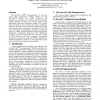5 search results - page 1 / 1 » Performance Evaluation of the PowerPC 620 Microarchitecture |
ISCA
1995
IEEE
13 years 8 months ago
1995
IEEE
The PowerPC 620TM microprocessor1 is the most recent and performance leading member of the PowerPCTM family. The 64-bit PowerPC 620 microprocessor employs a two-phase branch predi...
ICCD
1996
IEEE
13 years 9 months ago
1996
IEEE
There are four crucial issues associated with performance simulators: simulator retargetability, simulator validation, simulation speed and simulation accuracy. This paper documen...
IPPS
2000
IEEE
13 years 9 months ago
2000
IEEE
In a machine that follows the dynamically trace scheduled VLIW (DTSVLIW) architecture, VLIW instructions are built dynamically through an algorithm that can be implemented in hard...
MICRO
1996
IEEE
13 years 9 months ago
1996
IEEE
For decades, the serialization constraints imposed by true data dependences have been regarded as an absolute limit--the dataflow limit--on the parallel execution of serial progra...
HPCA
2006
IEEE
14 years 5 months ago
2006
IEEE
Simulation is an important means of evaluating new microarchitectures. Current trends toward chip multiprocessors (CMPs) try the ability of designers to develop efficient simulato...

